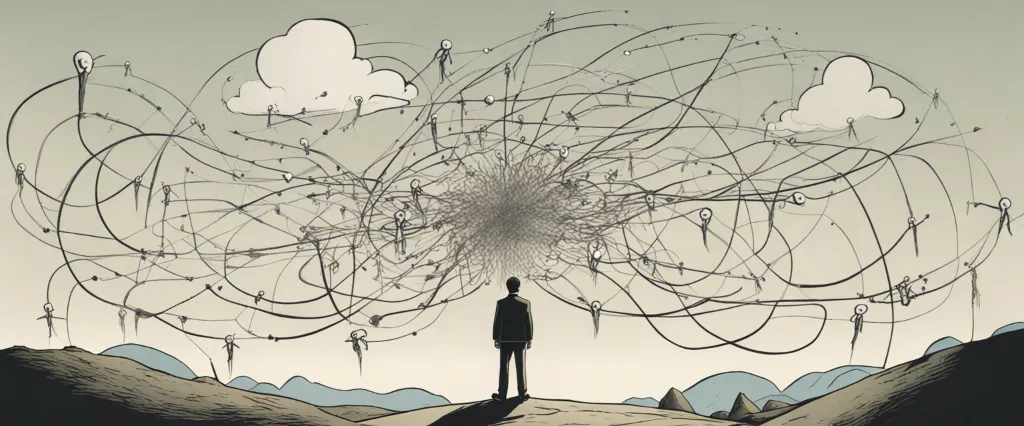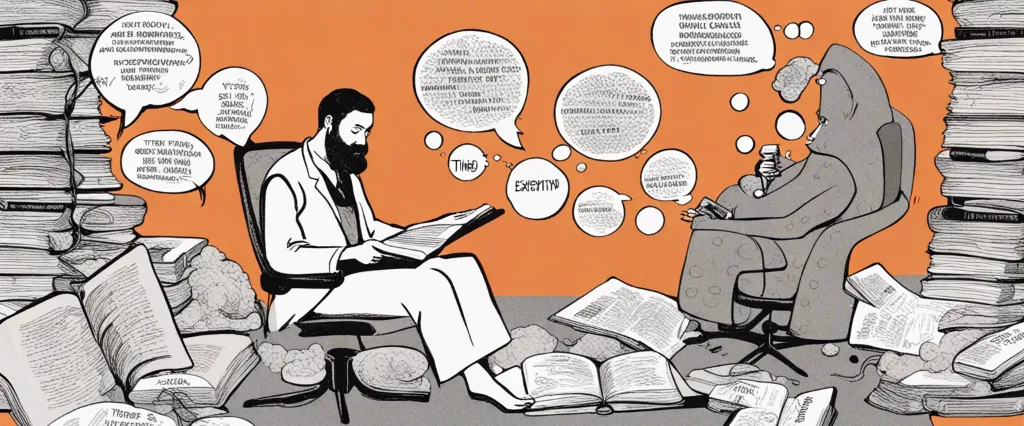In “This Explains Everything: Deep, Beautiful, and Elegant Theories of How the World Works,” John Brockman gathers the illuminating perspectives of leading scientists and thinkers who shared their undeniable insights into the nature of our reality. This remarkable book delves into the most profound questions, offering a diverse collection of essays that provide captivating explanations for a multitude of phenomena. Compiled by John Brockman, a literary agent and founder of the online forum Edge.org, “This Explains Everything” invites readers on an eye-opening journey through the cutting edge of scientific understanding.
Chapter 1: The Nature of Reality
Chapter 1 of the book This Explains Everything by John Brockman explores the nature of reality and presents a variety of perspectives on how we perceive and understand the world around us.
The chapter starts by discussing the concept of reality as a subjective experience. It suggests that reality is not an objective, fixed entity, but rather a construction influenced by individual experiences, perceptions, and biases. Different contributors to the book emphasize that our view of reality is shaped by our senses, cognitive processes, and cultural backgrounds. For example, Nobel laureate Daniel Kahneman suggests that our understanding of reality is constrained by biases and heuristics that affect our decision-making.
Furthermore, this chapter delves into the idea that our perception of reality is shaped by scientific inquiry. Scientists provide evidence-based explanations that allow us to understand and describe phenomena in the world. They help us build mental models of reality by identifying patterns, making predictions, and uncovering underlying mechanisms. For instance, physicist Carlo Rovelli argues that scientific theories are provisional and subject to change as new evidence emerges, which affects our understanding of reality.
The chapter also examines the concept of simulation theory, which proposes that our reality could potentially be a simulation created by an advanced civilization. This perspective sparks philosophical and scientific debates about the nature of our existence and challenges our traditional understanding of reality.
In summary, Chapter 1 of “This Explains Everything” presents a collection of viewpoints suggesting that reality is not a fixed, objective entity, but rather a subjective construct shaped by our senses, cognitive processes, cultural backgrounds, and scientific investigation. It challenges our understanding of reality by exploring the influence of biases, the importance of evidence-based explanations, and even the possibility that our reality might be a simulated existence.
Chapter 2: The Origins of Life
Chapter 2: The Origins of Life delves into the various theories surrounding the origins of life on Earth, as explored by different scientists and thinkers. The chapter begins by emphasizing the importance of understanding the origin of life as a fundamental scientific question, with implications for our understanding of biology, chemistry, and the nature of the universe itself.
The chapter first introduces the idea of abiogenesis, the notion that life emerged from non-living matter through chemical processes. It examines the Miller-Urey experiment, which demonstrated that amino acids, the building blocks of life, could arise spontaneously under the conditions believed to be present on early Earth. This experiment provided significant support for the theory of abiogenesis.
An alternative theory discussed in the chapter is panspermia, which proposes that life may have originated elsewhere in the universe and spread to Earth through comets or meteorites. This theory is based on the idea that the building blocks of life are widespread in the cosmos and can survive the journey through space. Panspermia raises questions about the origin of life itself but does not specifically address how life arose initially.
Additionally, the chapter examines the concept of RNA world, which suggests that early life forms relied on RNA (ribonucleic acid) rather than DNA (deoxyribonucleic acid) for genetic coding. This theory posits that RNA acted as both genetic material and enzymes, playing a central role in the emergence of life.
Finally, the chapter explores the idea of self-organization, proposing that life could be a natural consequence of complex systems organizing themselves. The complexity of life on Earth, according to this theory, emerges from simple interactions between molecules and their surroundings.
In summary, Chapter 2 provides an overview of different theories on the origins of life, including abiogenesis, panspermia, RNA world, and self-organization. Each theory contributes unique perspectives to our understanding of the emergence of life on Earth, highlighting the ongoing quest for answers to this fundamental question in science.
Chapter 3: The Human Mind
Chapter 3: The Human Mind explores various perspectives on the complexity and capabilities of the human mind. The chapter begins with Alison Gopnik, who argues that children’s minds are more flexible and imaginative than those of adults. She suggests that adults can learn from children, especially in their ability to explore and adapt to new ideas.
Next, Daniel C. Dennett explains his theory of the mind as a collection of “mindless robots,” referring to the countless individual processes happening in our brain that give rise to conscious experiences. He believes that the mind is not a centralized and singular entity, but rather a network of interconnected processes that work in conjunction.
Steven Pinker delves into the concept of language as a key feature of the human mind. He suggests that grammar and language have evolved over time to enhance our ability to communicate complex thoughts with precision and efficiency. Pinker argues that the human mind is specialized for acquiring and using language, making it a unique cognitive trait.
Lisa Randall explores the intersection of the human mind and the cosmos. She discusses how our mind’s ability to understand and interpret the universe has been shaped by evolution. Randall emphasizes the importance of combining scientific and philosophical knowledge to gain a deeper understanding of the universe and our place within it.
The chapter also features contributions from other scientists, philosophers, and scholars who offer insights into various aspects of the human mind. These include discussions on consciousness, self-awareness, decision-making, and the role of emotions in shaping our thoughts and actions.
Overall, Chapter 3 showcases a diverse range of perspectives on the human mind, highlighting its complexity, adaptability, and its unique capacity for language and understanding the universe.
Chapter 4: Evolution and Genetics

Chapter 4 of “This Explains Everything” by John Brockman explores the fascinating field of evolution and genetics. The chapter features various expert contributions, all aiming to shed light on the fundamental principles underlying these concepts.
One key theme is the concept of evolution as an ongoing process. Evolution occurs through the gradual accumulation and selection of beneficial genetic mutations over time. As organisms reproduce and pass their genetic information to their offspring, new variations arise. These variations, combined with environmental pressures, determine an organism’s survival and reproductive success. This process of natural selection leads to the adaptation and diversification of species over generations.
Geneticist George Church discusses the potential of emerging biotechnologies, such as synthetic biology and genome editing, to accelerate the evolution process. By directly manipulating the genes of organisms, scientists can potentially enhance desirable traits or even create new species altogether.
Evolutionary psychologist David P. Barash explores the concept of sexual selection, emphasizing the role it plays in shaping the physical and behavioral traits of animals. The preferences of one sex for certain traits, such as colorful feathers in birds or elaborate antlers in deer, drive the evolution of these characteristics.
The chapter also delves into the genetic mechanisms that underpin evolution. Geneticist and virologist Svante Pääbo shares insights into our evolutionary past by studying ancient DNA, particularly that of Neanderthals and Denisovans. By analyzing these genomes, Pääbo and his team uncover fascinating details about human evolution and the interbreeding that occurred between Homo sapiens and these ancient hominin species.
In summary, Chapter 4 of “This Explains Everything” delves into the profound concepts of evolution and genetics. It explores the ongoing nature of evolution, the role of sexual selection in shaping species, and the genetic mechanisms that drive evolutionary change. The chapter also highlights the exciting potential of new biotechnologies in accelerating and manipulating the evolutionary process.
Chapter 5: Complexity and Emergence
Chapter 5 of “This Explains Everything” by John Brockman explores the concepts of complexity and emergence. Complexity refers to intricate systems or phenomena that have many interconnected components, making it difficult to understand or predict their behavior. Emergence, on the other hand, describes how complex systems can give rise to new properties or behaviors that cannot be directly explained by their individual components.
The chapter begins with biologist Stuart Kauffman arguing that complexity arises through a process called self-organization, where simple elements interact and organize themselves into more complex structures. He suggests that complex systems have a range of possible behaviors or states, and as they evolve, they traverse this space of possibilities, resulting in emergent properties.
Other contributors discuss emergence in various scientific fields. Physicist George F. R. Ellis highlights the importance of emergence in understanding cosmology, as the universe exhibits emergent properties not predicted by the fundamental laws of physics. Neuroscientist Karl Friston emphasizes how the brain’s emergent properties give rise to consciousness and subjective experience.
Biologist Paul Davies suggests that emergence plays a crucial role in the origins of life. He argues that the transition from non-living to living matter involved the emergence of new properties, such as replication and metabolism. Similarly, economist Brian Arthur discusses how economies exhibit emergent behaviors, where the interactions of individuals lead to patterns and phenomena not anticipated by any individual.
Overall, the chapter explores how complex systems can exhibit emergent behaviors and properties that cannot be easily reduced to the characteristics of their individual components. The concept of emergence challenges reductionist approaches and highlights the inherent intricacy in understanding and predicting the behavior of complex systems across various scientific disciplines.
Chapter 6: The Future of Technology
Chapter 6 of “This Explains Everything” by John Brockman explores the future of technology and its potential impact on various aspects of society. The chapter is a compilation of essays by leading thinkers and experts in the field who share their perspectives and predictions.
The contributors address the rapid advancements in technology and the resulting implications. One of the main themes is the concept of technology becoming increasingly ubiquitous and seamlessly integrated into our daily lives. They discuss how emerging technologies like artificial intelligence (AI), virtual reality, and augmented reality will shape various industries such as healthcare, education, and entertainment.
The chapter examines the potential benefits and drawbacks of these advancements. On the positive side, experts anticipate significant improvements in healthcare, with AI aid in diagnosis and treatment, and the ability to tailor personalized medicine. Education is also expected to be transformed, with interactive and immersive learning experiences becoming the norm.
However, concerns are raised about the impact of automation on jobs and the economy. There is a recognition that the workforce will need to adapt to these changes, and there might be a need for new forms of social safety nets.
The chapter also touches on the ethical implications of technology. The contributors address the need for a thoughtful approach to its development and usage, highlighting issues like privacy, security, and the potential for misuse. They emphasize the importance of responsible innovation and regulation to mitigate these risks.
In summary, Chapter 6 delves into the exciting possibilities and challenges that lie ahead as technology continues to evolve rapidly. It examines the potential transformations in different sectors and raises important considerations regarding the societal impact of these advancements.
Chapter 7: The Limits of Knowledge
Chapter 7 of “This Explains Everything” by John Brockman explores the idea of the limits of human knowledge. The chapter contains contributions from several experts in different fields who offer their perspectives on knowledge boundaries.
The chapter begins with a discussion on the scientific method and its ability to provide reliable knowledge. It highlights the importance of skepticism and the constant questioning of existing theories and ideas. An example is given where the lack of evidence for something doesn’t necessarily mean it is false, but rather that it is yet to be proven.
Scientists also debate the concept of falsification, which suggests that a scientific theory must be testable and potentially proven wrong to be considered valid. Some argue that not all scientific theories can be falsified, and therefore, the concept may limit our understanding in certain areas of knowledge.
Another aspect explored is the relationship between knowledge and perception. Our subjective experience of reality is based on our limited sensory organs and brain capacities, which means our knowledge is inherently limited by our perception.
The chapter also delves into the human capacity for understanding complex phenomena. Certain concepts, such as consciousness and the nature of reality, are inherently difficult to comprehend fully due to their complex nature, leading experts to question whether we can ever truly have a complete understanding of the universe.
In conclusion, Chapter 7 of “This Explains Everything” offers insights into the limitations of our knowledge. It highlights the importance of skepticism in science, addresses the challenges of falsification and the role of perception in shaping our understanding, and questions the extent to which we can comprehend complex phenomena. Overall, the chapter emphasizes the need for humility and ongoing exploration in our pursuit of knowledge.

Chapter 8: The Meaning of Life
Chapter 8 of the book “This Explains Everything” by John Brockman is titled “The Meaning of Life.” In this chapter, the author poses the question to numerous scientists and thinkers, asking them to share their perspectives on the meaning and purpose of life.
The chapter begins by highlighting the wide range of answers given by the respondents. Some contemplate that life may have no inherent meaning and suggest that we must create our own purpose. Others provide more spiritual or religious interpretations, suggesting that the meaning of life could be found in love, connection, or the pursuit of knowledge.
One key theme that emerges is the idea that the meaning of life lies in the process of becoming. The journey, growth, and development that life offers are seen as significant and meaningful in themselves. One contributor explains that life is a dynamic process, constantly evolving, and that the true value lies in the experiences and interactions we have along the way.
Another common perspective focuses on the importance of human connection and the impact we have on others. Many contributors suggest that the purpose of life is to make a positive difference in the world, leaving a legacy of love, compassion, or knowledge that will endure beyond our lifetimes.
Overall, the chapter presents a variety of viewpoints on the meaning of life. While there may not be one definitive answer, the contributors highlight the significance of personal growth, relationships, and making a positive impact as central elements in finding purpose and meaning in our lives.
After Reading
In conclusion, John Brockman’s book “This Explains Everything” captures the fascinating perspectives and insights of prominent scientists and thinkers from various disciplines. The collection of essays delves into profound questions about life, the universe, and everything in between, seeking to uncover and explain the underlying principles that govern our existence. Through these diverse viewpoints, readers are encouraged to challenge their preconceived notions and explore the limitless potential of human knowledge. This thought-provoking book serves as a breathtaking exploration of the mysteries of our world and leaves readers with a sense of awe and wonder about the complexity and interconnectedness of everything around us.
1. What If?: Serious Scientific Answers to Absurd Hypothetical Questions by Randall Munroe
Randall Munroe, the creator of the popular webcomic xkcd, explores and answers absurd but fascinating hypothetical questions using scientific principles. Similar to This Explains Everything, Munroe’s book takes complex concepts and presents them in an entertaining and accessible way, addressing a wide range of topics from physics to biology.
2. The Invisible Gorilla: How Our Intuitions Deceive Us by Christopher Chabris and Daniel Simons
In The Invisible Gorilla, Chabris and Simons explore the limitations of human perception and cognition. Much like Brockman’s book, this work challenges conventional wisdom and uncovers the surprising ways in which our minds can deceive us, offering intriguing insights into how we construct our understanding of the world.
3. The Information: A History, a Theory, a Flood by James Gleick
James Gleick’s The Information examines the role of information and its impact on society throughout history. Building upon the idea of knowledge and explanation, Gleick explores how information theory has shaped our understanding of the universe, communication, and ourselves. This book will take you on a captivating journey through the evolution of ideas.
4. The Stuff of Thought: Language as a Window into Human Nature by Steven Pinker
Steven Pinker explores the intricacies of language and how it shapes our perception of reality in The Stuff of Thought. This book delves into the connections between linguistics, psychology, and philosophy, shedding light on the profound impact language has on our thoughts and experiences. Much like This Explains Everything, it examines the fundamental aspects of human cognition.
5. The Brain that Changes Itself: Stories of Personal Triumph from the Frontiers of Brain Science by Norman Doidge
Norman Doidge investigates the concept of neuroplasticity and its implications in The Brain that Changes Itself. This engaging book showcases stories of individuals who have overcome brain injuries and disabilities through the power of the brain’s ability to rewire itself. Reflecting This Explains Everything’s exploration of the human mind, Doidge’s work unfolds a fascinating account of how the brain adapts and changes its structure.
These five books provide captivating insights into diverse realms of knowledge and challenge conventional thinking, much like John Brockman’s This Explains Everything. Pick any of these titles based on your interests and prepare to embark on a captivating intellectual journey.




